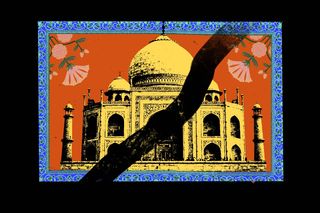
Why Hindu Nationalists Want to Erase Mughal History
The Mughal dynasty’s presence in Indian history threatens the idea of a homogenous Hindu past — and thereby, the idea of India as Hindu.

Last Saturday, the Union Government changed the name of the Mughal Gardens in the Rashtrapati Bhavan premises to “a common name” — Amrit Udyan. The name change, marking the celebrations of Azaadi ka Amrit Mahotsav prompted leaders from the ruling party to note that it showed India coming out of a “slave mentality.” Kiren Rijuju, the law minister of the country, tweeted that the name change signaled “a powerful symbol of our nation’s progress and a reflection of a brighter future for New India.”
The Mughal Empire refers to the dynasty that reigned over large parts of South Asia — including the Indian subcontinent — during the 16th-19th centuries. These name changes aren’t isolated incidents, and the ruling party’s association of “slave mentality” with Mughal names is reflective of the Hindu nationalist desire to erase the presence of Mughals from the public sphere — and memory. It also shows how the Mughal Empire is often conflated with British rule in India, in service of the narrative that Muslim rulers have colonized a Hindu country.
Accordingly, in the last nine years, Hindu nationalist governments at both the union and state levels have changed the names of several places, monuments, and institutions with Mughal roots. In 2018 the Uttar Pradesh state government led by Yogi Adityanath changed the name of Allahabad — a city christened by the Mughal emperor Akbar — to Prayagraj. The same year, the state government also renamed the erstwhile Mughal Sarai Railway Station after Jan Sangh ideologue Deen Dayal Upadhyay.
Followers of the ideology of Hindutva and Hindu nationalism have always projected Mughals as one of the biggest villains of India’s glorious and unbroken Hindu past. Since its inception, the Hindutva project has been preoccupied with redefining the question of who the authentic “Indian” is. The ideology propagates the idea that a Hindu and a Muslim can never live together in peace and harmony — not until, at least, the aspects of the Muslim’s religious and cultural identity are subdued in favor of a Hindu nationalistic identity. The Mughals thus become a key historical and cultural institution to erase in this regard, as their role in shaping the country as it is today speaks to how Muslims comprise an integral part of defining an “Indian.”
Thus, many political leaders portray Mughals as villainous — this is a trope that has spread to Bollywood depictions as well. This is also evident in ongoing campaigns against Mughal-era mosques in Ayodhya, Mathura, and Varanasi. The more recognizable of these relics are often co-opted into alternative historical narratives — as the bid to identify the Taj Mahal as Hindu temple Tejo Mahalay demonstrates.
Mughal erasure hasn’t been confined just to public places and monuments. Last year, the National Council of Education, Research, and Training (NCERT), the body that is responsible for designing textbooks, in their move to achieve “rationalistion of contents in textbooks” in the country, decided to remove chapters on Mughals from secondary school textbooks. Before that, in 2017, the Maharashtra government omitted chapters on the Mughals and the Delhi Sultanate from the history books, even removing the mention of the monuments from the books. Earlier in that same year, in Rajasthan, both the school education board as well as the Rajasthan University changed their history textbooks. They claimed that it was the Rajput hero Maharana Pratap — and not his adversary, the Mughal ruler Akbar — who emerged victorious in the Battle of Haldighati. “In fact all heroes — from Pratap to Prithviraj Chauhan — that the RSS is projecting had lost conclusively. By twisting facts one cannot re-write history,” professor D N Jha, former member of Indian Council for Historical Research, told Hindustan Times.
Related on The Swaddle:
UGC Drafts New History Syllabus To Include “Idea of Bharat,” Chapters on Religious Texts
In speeches and political rallies, Hindutva leaders have constantly evoked the narrative of Mughals as colonizers, and emphasized their defeat by Hindu leaders. Often, this has served as a dog-whistle against present-day Muslims. During the Assam elections in 2016, Hindutva nationalists began calling their campaign the “Last Battle of Saraighat,” referring to a 17th Century battle between the Ahoms and the Mughals, in which the Ahoms, led by Lachit Borphukan, were able to prevent the Mughals from breaching the borders of the Ahom kingdom. Hindu nationalists won the election, successfully mixing local anti-outsider sentiments with Hindutva’s anti-Muslim stance. In Maharashtra, similarly, Chhatrapati Shivaji — a known adversary of Mughal ruler Aurangzeb is re-imagined and co-opted as a Hindutva hero. Both Lachit and Shivaji were not anti-Muslim rulers, but their opposition to Mughal domination is enough to carve them out as heroes of Hindutva.
Implicit in these assertions is that Hindu nationalists identify Mughals as not only Muslims but also as “outsiders,” rulers not being indigenous to the land. But the history of any place is the history of generations of migrations. The Mughals were not the only dynasty that arrived and settled in South Asia from elsewhere. For instance, the Ahoms who fought the Mughals to deny them entry into the northeastern part of present-day India, themselves originated from Tai people, an ethnic conglomeration of people historically living in South China and Southeast Asia. Similarly, in the ancient period, Indo-Greeks, Kushans, Huns, and other ruling groups established their reign over parts of northern India. The notions of indigeneity under which Mughals are treated by Hindu nationalists as outsiders, then, fall flat upon closer scrutiny.
It is true that Babur, the founding emperor of the Mughal dynasty, came to the South Asian subcontinent from Uzbekistan. It is however also true that Babur’s descendants made the subcontinent their home, completely adapting and influencing the culture of the land they lived in. The now rechristened garden in the Rashtrapati Bhavan laid out in the style of the Mughal charbagh is just one example of how Mughal aesthetics continued to influence what signified “Indian” long after their reign ended. Other architectural styles the Mughals — and other Indian Muslim empires in the subcontinent — employed to design their buildings found their way into a new architectural style that the British coined “saracenic.” Many important institutions of modern India, including the Madras High Court, and the Chhatrapati Shivaji Maharaj Terminus, are built in saracenic styles.
Historians and academics have thus long opposed Hindu nationalists’ attempts to portray Mughals as simply a unidimensional Muslim dynasty, pointing out how Mughal courts often employed many Hindu noblemen. In fact, while Hindu nationalists evoke Maharana Pratap, the Rajput ruler who fought against Akbar, as a Hindu hero, they ignore the fact that several Rajputs were also in important alliances with Mughal rulers. In fact, there was a strong exchange of cultures between Rajputs and Mughals. For instance, inspired and influenced by the culture of miniature paintings in Mughal courts, the Rajputs too developed their own miniature style painting. The Muslim Mughals, on the other hand, on coming into contact with Hindu rituals thanks to their Rajput relatives, started celebrating and commemorating Hindu festivals and rituals, as mentioned in their memoirs and depicted in their paintings.
The history of the Mughals and the rich cultural heritage they have left behind, threatens the Hindutva narrative of portraying Muslims as outsiders. Renaming monuments and cities is part of a larger cultural erasure of the Mughals, whose memory and persistent influence in our culture threaten the narrative of a homogenous Hindu history. As the historian Romila Thapar noted: “should we not ask questions of existing knowledge to enable us to know what we are and what we want to be?”
Amlan Sarkar is a staff writer at TheSwaddle. He writes about the intersection between pop culture and politics. You can reach him on Instagram @amlansarkr.
Related


Massive, Impersonal Tech Layoffs Show How “Good Jobs” Need Unions Too
